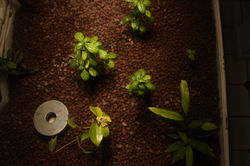Modular Farming 1.0 Aquaponics Pilot

In the may of 2018, I was introduced to soil-less agriculture. A novel method of growing food without soil. It uses 95% less water and 50% less area compared to conventional agriculture for the same output.
The Science:
Water
In the absence of soil, the plants grow directly in enriched water. They’re placed in such a way that the roots are constantly in contact with the water and the body of the plant is held in place with external support. All nutrition needed by a plant is delivered through the water and absorbed by the roots. This water constantly circulates in a closed loop thus drastically reducing the total water requirement.

There are two major systems within soil-less agriculture, differentiated by the source of nutrition.
Hydroponics and Aquaponics.
Hydroponics
In Hydroponics, the nutrition is supplied in a powdered form by dissolving it directly in the water. These essential nutrients include Nitrogen, Potassium, Phosphorus, Iron, and Calcium among others. The nutrients are replenished periodically as the plants absorb them. This is the more popular form of soil-less agriculture.
Aquaponics
As for aquaponics, it is slightly different. Aquaponics combines aquaculture with hydroponics. Therefore fish and plants grow in the same re-circulating water. The fish are fed a protein rich feed and excrete waste that is high in nitrogen. This waste is naturally nitrified and used as nutrition by the plants. It’s an excellent way to utilise and reuse aquaculture run-off which is otherwise hard to dispose of.


Inspired by the novelty of the concepts, I started working at Red Otter Farms, one of the only commercial aquaponic farms in India, located in Nainital. With my learnings from that experience, I set up this pilot module to continue my R&D.
The Set-up
Build


The re-circulating nature of these systems makes them highly sustainable. In keeping with the principle, I used reclaimed and up-cycled materials for the build. These include discarded bulk containers, angle beams from industrial scrap and repurposed fuel-drums.

A major issue we faced at Red Otter was that of high temperatures. To eliminate that, I built the set up indoors in an old kitchen. Now kitchens are not designed from the perspective of being repurposed as farms later. Hence the space was not perfectly suited to the objective. Optimising it required modifying the system orientation and even the room dimensions in places. Walls were drilled to make way for the piping and a cavity had to be dug in the ground to ensure smooth water flow.

Measurements from the initial screening of the kitchen

exploring different tank placement settings.

Frame installed for the upper tank and cavity dug for the lower one

The total build time was 22 days from scratch to filling the system with water. A plumber and mason were hired to help with the piping and fabrication. The fingerlings were sourced from a local fish farm.

Troubleshooting
Having limited experience of designing systems, my plan needed revisions at every step. Consequently it got better after every set back.
I had problems with temperature control. As we approached winter, I lost ~50 fish in one day because the water became too cold. Another time I lost ~100 fish as an electricity failure caused the aeration to stop and oxygen levels plummeted. I had issues with overflowing pipes, and with unbalanced light exposure among the plants.

High water pressure caused pipes to overflow

Range controlled water heater to maintain stable temperature

Rust marks on the steel filter

Uneven growth among plants
The system is now equipped with automated temperature control, electric back up, bigger pipes, and regulators for water flow as well as light exposure. I still face issues, but these ones haven’t surfaced again and I haven't lost a single fish since.

Automatic switch to time light exposure

Larger pipes to accommodate water flow

Plants growing under a spectrum controlled light
Conclusion
A system as small as this can produce upto 60 heads of lettuce per week without any additional water. It is very resource efficient. Setting this up independently was challenging. This was my first attempt at making a functional installation.

My primary motive behind this project was to explore the viability of the technology at a low scale. And I can safely say that it is very expensive to practice soil-less, climate controlled agriculture in India. The fixed costs aside, running the system smoothly takes its toll on the wallet. That being said, these costs will come down as the knowledge about the technology spreads and more people get involved. The absence of an ecosystem around the technology is a major driver of the costs.
The cost per unit of output also depends on how well the space is being utilised. As for this pilot project, my emphasis was more on the technology and not on the efficiency. Hence there is scope to reduce the costs within the existing set up. This theme is explored in Soil-less Agriculture 1.1
Gallery
 |  |  |
|---|---|---|
 |  |  |
 |  |  |


